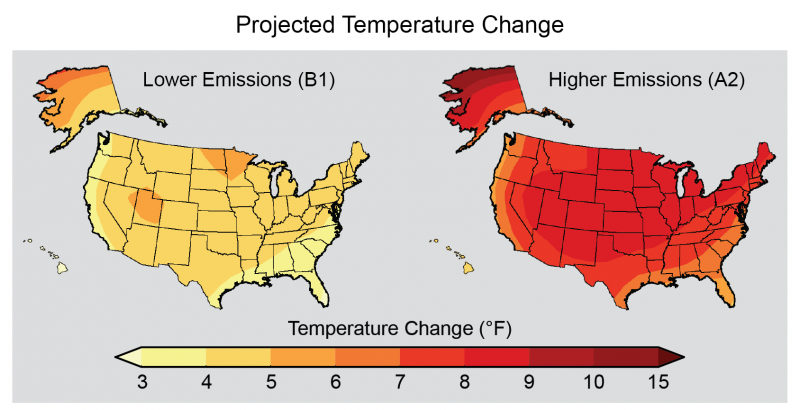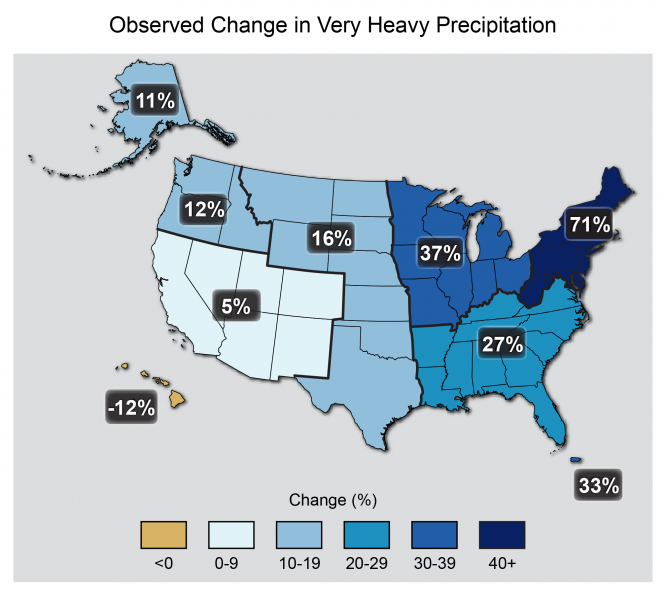Maps show projected change in average surface air temperature in the later part of this century (2071–2099) relative to the later part of the last century (1970–1999) under a scenario that assumes substantial reductions in heat trapping gases (B1) and a higher emissions scenario that assumes continued increases in global emissions (A2).

Food
- Climate disruptions to agricultural production have increased over the past 40 years and are projected to increase over the next 25 years. Farmers and ranchers will likely need to increase their rate of innovation and adaptation to keep pace with this projected change.
- Crop and livestock production in many agricultural regions will likely decline due to weeds, diseases, insects, and climate-related stresses.
- The rising incidence of extreme weather—including heat waves, drought, and very heavy precipitation—will increasingly impact crop and livestock productivity.
- Climate-related changes in crop yields and food prices as well as impacts on food processing, storage, and distribution systems can impact food security.
Key points:
Extreme weather, climate variability and climate change pose challenges to U.S. and global food systems.1 According to the Third National Climate Assessment, climate-related disruptions to agricultural production have increased since the mid-1970s and are projected to continue to increase over the next 25 years, and it is anticipated that by 2050 and beyond these impacts will be increasingly negative on most crops and livestock.1
Climate-related variables, such as temperature, precipitation, and extreme weather will affect crop, livestock, and fisheries yields, handling requirements for safe food, and storage methods necessary to prevent spoilage. The infrastructure required to reliably and efficiently transport food will also be affected. Combined, these factors will influence availability and affordability of food products, posing particular challenges for underdeveloped countries coping with food insecurity.
To many American consumers, food production seems uncomplicated—they see only the products that end up on grocery store shelves. The reality, however, is far from simple. The food system is a complex web of interactions among producers, processors, distributors, and consumers.2 Climate and weather affect the entire food system. For example, precipitation can influence crop and livestock productivity, temperature can determine spoilage rates and contamination, and storms can impact transportation infrastructure. Each of those effects can combine to influence food prices.
Agricultural producers have been continuously improving plant and animal varieties. Management regimes today maximize productivity under contemporary climatic conditions and weather patterns that had been relatively stable from the birth of the United States up to the widespread use of fossil fuels. Similarly, food processors and distributors have fine-tuned their operations to minimize food loss and maximize profitability under historic climate conditions and weather patterns. Climate change, however, is shifting those baseline conditions and variability uniquely in each region of the globe. Where those shifts have negative impacts, food producers, processors, and distributors will have to adapt their operations to remain profitable and consumers may have to adjust their behavior to continue to receive safe and nutritious food. The ability to adjust to climate variability and change through alterations in behavior, technology, and resources is known as “adaptive capacity.”
The U.S. food system as a whole has a high adaptive capacity because of our access to knowledge, technology, and capital. Despite our capabilities, however, yields of major U.S. crops and farm returns are projected to decline by mid-century3, and processors and distributors will face challenges both from climate change and rising energy prices.3 Developing countries are especially vulnerable to climate change because of low adaptive capacity, and because many are in geographic locations that are expected to be hit the hardest by climate change’s physical effects.4
- Food Production: The effect of climate change on crop productivity through temperature, precipitation, and extreme weather will vary by region. Climate disruptions to agricultural production have increased in the past 40 years and are projected to continue to increase over the next 25 years. By mid-century and beyond, these impacts will be negative on most crops and livestock.1
- Food Distribution: Projected rising temperatures, changing weather patterns, and increases in frequency of extreme weather events could affect food trade and distribution. Storage and transport infrastructure and protocols may need to be modified to prevent spoilage and cope with weather damage.
- Food Safety and Nutrition: Climate change and variability could increase the occurrence of food safety hazards throughout the food chain, from primary production through consumption.5 Additionally, a rise in atmospheric carbon dioxide may affect the nutrient content of staple foods.
- International Food Security: Climate change effects on the whole food system will have consequences for global food security, through changes in crop yields and effects on food processing, storage, transportation, and retailing, all of which influence food prices.1 As outlined by the Food and Agriculture Organization (FAO) of the United Nations, food security is influenced by availability (food production and stocks), access (affordability and distribution systems), utilization (safety and nutritional value), and stability (reliability of access and production in the face of weather, price, economic, and political fluctuations). FAO defines food security as "when all people, at all times, have physical and economic access to sufficient, safe, and nutritious food to meet their dietary needs and food preferences for an active and healthy life."
- 1. a. b. c. d. Hatfield, J., G. Takle, R. Grotjahn, P. Holden, R.C. Izaurralde, T. Mader, E. Marshall, and D. Liverman, 2014: Ch. 6: Agriculture. Climate Change Impacts in the United States: The Third National Climate Assessment, J.M. Melillo, Terese (T.C.) Richmond, and G.W. Yohe, Eds., U.S. Global Change Research Program, 150-174. doi:10.7930/J02Z13FR.
- 2. Ericksen, P.J., J.S.I. Ingram, and D. Liverman, 2009: Food security and global environmental change: Emerging challenges. Environmental Science and Policy, 12, 373–377, doi:10.1016/j.envsci.2009.04.007.
- 3. a. b. Walthall, C.L., J. Hatfield, P. Backlund, L. Lengnick, E. Marshall, M. Walsh, S. Adkins, M. Aillery, E.A. Ainsworth, C. Ammann, C.J. Anderson, I. Bartomeus, L.H. Baumgard, F. Booker, B. Bradley, D.M. Blumenthal, J. Bunce, K. Burkey, S.M. Dabney, J.A. Delgado, J. Dukes, A. Funk, K. Garrett, M. Glenn, D.A. Grantz, D. Goodrich, S. Hu, R.C. Izaurralde, R.A.C. Jones, S-H. Kim, A.D.B. Leaky, K. Lewers, T.L. Mader, A. McClung, J. Morgan, D.J. Muth, M. Nearing, D.M. Oosterhuis, D. Ort, C. Parmesan, W.T. Pettigrew, W. Polley, R. Rader, C. Rice, M. Rivington, E. Rosskopf, W.A. Salas, L.E. Sollenberger, R. Srygley, C. Stöckle, E.S. Takle, D. Timlin, J.W. White, R. Winfree, L. Wright-Morton, and L.H. Ziska, 2012: Climate Change and Agriculture in the United States: Effects and Adaptation, USDA Technical Bulletin 1935, 186 pp.
- 4. Mendelsohn, R., A. Dinar, and L. Williams, 2006: The distributional impact of climate change on rich and poor countries. Environment and Development Economics, 159–178, doi:10.1017/S1355770X05002755.
- 5. Tirado, M.C., R. Clarke, L.A. Jaykus, A. McQuatters-Gollop, and J.M. Frank, 2010: Climate change and food safety: A review. Food Res. Int., 43, 1745-1765. doi:10.1016/j.foodres.2010.07.003.



